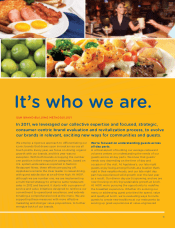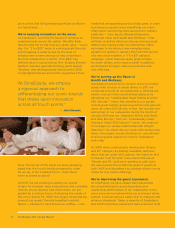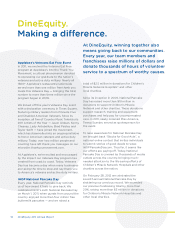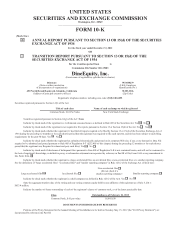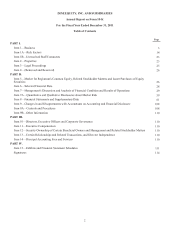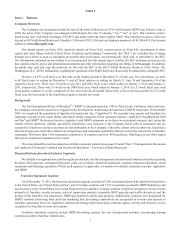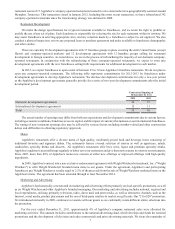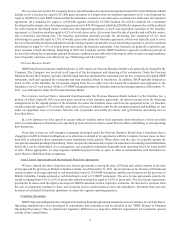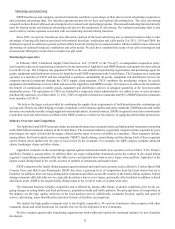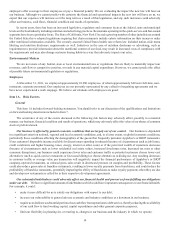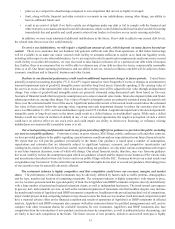IHOP 2011 Annual Report Download - page 23
Download and view the complete annual report
Please find page 23 of the 2011 IHOP annual report below. You can navigate through the pages in the report by either clicking on the pages listed below, or by using the keyword search tool below to find specific information within the annual report.
5
Since the completion of the Applebee's acquisition, we have been executing a strategy to transition from an Applebee's
system that was 74% franchised at the time of the acquisition to a 99% franchised system, similar to IHOP's 99% franchised
system. As of December 31, 2011, the Applebee's system is 91% franchised. In order to complete this strategy, we plan to franchise
substantially all of the remaining company-operated Applebee's restaurants while retaining 23 restaurants in one company market
in the Kansas City area. This highly franchised business model is expected to require less capital investment, improve margins,
and reduce the volatility of cash flow performance over time, while also providing cash proceeds from the refranchising of the
company-operated restaurants for the retirement of debt.
As of December 31, 2011, we had 71 franchise groups, including 29 international franchise groups. We have generally
selected franchisees that are experienced multi-unit restaurant operators. Many franchisees have operated or concurrently operate
other restaurant concepts. We have assigned development rights to the vast majority of domestic areas in all states except Hawaii
and the company-operated markets.
Domestic Franchising
As of December 31, 2011, there were 1,694 domestic Applebee's franchise restaurants. During 2011, 15 domestic franchise
restaurants opened, six domestic franchise restaurants closed and 132 company-operated restaurants were franchised. The number
of restaurants held by an individual franchisee ranges from one to 338 restaurants. The table below sets forth information regarding
the number of Applebee's restaurants owned by domestic franchisees as of December 31, 2011 as well as the total number of
restaurants falling into each of the listed ownership ranges.
Number of Restaurants Held by Franchisee
One to ten
Eleven to twenty-five
Twenty-six to fifty
Fifty-one to one hundred
Greater than one hundred
Total (a)
Franchisees
Number
8
13
12
7
2
42
Percent
of Total
19.0%
31.0%
28.6%
16.7%
4.8%
100.0%
Restaurants
Number
53
234
474
492
441
1,694
Percent
of Total
3.1%
13.8%
28.0%
29.0%
26.0%
100.0%
_______________________________________________
(a) Percentages may not add due to rounding.
International Franchising
We continue to pursue franchising of the Applebee's concept as the primary method of international expansion. To this end
we seek qualified franchisees that possess the resources needed to open multiple restaurants in each territory and are familiar with
the specific local business environment in which they propose to develop and operate Applebee's restaurants. We currently are
focusing on international franchising primarily in Canada, Mexico, Central and South America, and the Mediterranean/Middle
East.
We work closely with our international franchisees to develop and implement the Applebee's system outside the United
States, recognizing commercial, cultural and dietary diversity. Differences in tastes and cultural norms and standards mean we
need to be flexible and pragmatic regarding many elements of the Applebee's system, including menu, restaurant design, restaurant
operations, training, marketing, purchasing and financing.
As of December 31, 2011, there were 148 international Applebee's franchise restaurants. During 2011, nine international
franchise restaurants opened and nine international franchise restaurants closed. The number of restaurants held by an individual
franchisee ranges from one to 22 restaurants. The table below sets forth information regarding the number of Applebee's restaurants
owned by international franchisees as of December 31, 2011 as well as the total number of restaurants falling into each of the
listed ownership ranges.


